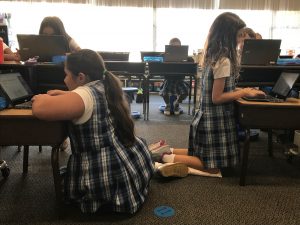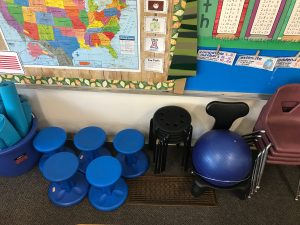The following article was contributed by Megan Schappert, third grade teacher at Holy Cross School in Santa Cruz, CA.
Why flexible seating? I was chatting with the second grade teacher the other day when she mentioned how excited her students were to choose their own seats in the third grade. Well yes, I do let my students choose where to sit each day, but there is so much more to it than that!
We live in a world where our students are in need of more than just a chair to sit in. They need to get up, move around and wiggle. This is where Flexible Seating comes into play. Before making any judgement about how I may be following the next teaching trend, please hear me out.
Is flexible seating a “go big or go home” type of trend? Do you have to do it all, buy it all and have the cutest and most trendy classroom out there? Not at all! Just adding a few different seating options and allowing the students choice is what I believe makes a classroom a flexible one. Can you imagine a class of squirrely eight and nine-year-olds picking their own classmates to sit next to and letting them sit on a bouncy ball? It sounds like chaos, but I have a class who can work quietly on their own and in small groups. As they do, they wobble back and forth, stand up, kneel or sit on the ground and some have heads bobbing slightly as they bounce.
Getting to this point took a month of “training” and careful choice of what items to have in my classroom. I spent the first weeks of school describing the seats and explaining how to use them and how not to use them. I stressed the importance of taking personal responsibility for their own education and encouraging them to find a “smart seat” – a seat where they can see the board, focus and not be distracted or be a distraction. My students know that I have the ultimate call and often I have asked students to reevaluate their seating choice.
 In my classroom I have three different levels of seating: standing desks, regular height desk and short desks for sitting on the floor. I have six different types of seats: exercise ball chairs, wobble stools, regular stools, crate seats, pillows and of course a standard classroom chair. I spent the first month placing students in desks and seat options so that they could experience each space and item. One day one of my boys had the exercise ball for about 30 minutes and asked if he could sit on something else, explaining that “this is not my thing.” I smiled and thanked him for knowing what worked best for him and allowed him to choose another seat option. Today that same boy is sitting on a standard classroom chair, while his neighbor is on a wobble stool.
In my classroom I have three different levels of seating: standing desks, regular height desk and short desks for sitting on the floor. I have six different types of seats: exercise ball chairs, wobble stools, regular stools, crate seats, pillows and of course a standard classroom chair. I spent the first month placing students in desks and seat options so that they could experience each space and item. One day one of my boys had the exercise ball for about 30 minutes and asked if he could sit on something else, explaining that “this is not my thing.” I smiled and thanked him for knowing what worked best for him and allowed him to choose another seat option. Today that same boy is sitting on a standard classroom chair, while his neighbor is on a wobble stool.
A bonus to flexible seating options is that it has actually eliminated the student desk mess problem. Because students choose a different seating option and space each day, there are no more assigned seats with desks stuffed to the brim with papers, toys, eraser bits and half chewed pencils. Each student is given a cubby, which holds only what is needed; a pencil box, notebooks and workbooks.
The desk mess no longer bogs down my classroom and most importantly, my students success.
I was lucky to have the support of the parents, who enjoy sitting on the alternative seating when we meet. I explained the purpose of the seating options, informing them that their child would be taking personal responsibility for their own education, starting simply by picking a seat to sit on!
